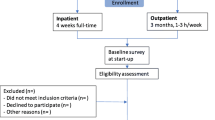Abstract
Introduction Return-to-work (RTW) after occupational injuries is an important and challenging issue. Case managers are expected to play a vital role in successful RTW. In China, RTW intervention is in its early phase and requires further research and practice. Objectives This case report describes Mr. H’s RTW process for illustrating the work of a case management team in China. Suggestions on developing and optimizing the process in China are given. Methods After 9 years of absence from work due to severe burn injuries at work, Mr. H was referred for RTW interventions. Mr. H received social and occupational rehabilitation services of 3 months, and the following workplace visits and work trials. After the job placement, the case manager continued the liaison with the worker and employer. Results Mr. H showed positive changes in occupational and social adjustment after the case management interventions. This was reflected from the shift from the contemplation to action stage on the Lam Assessment of Stages of Employment Readiness. Despite he did not show significant changes on functional capacity and fear avoidance beliefs, Mr. H passed the job credential test and was offered a maintenance technician position at a new company. Both the worker and the employer were satisfied with the outcome of the case management. Conclusions The RTW interventions carried out by the case managers appeared to be effective within the Chinese system. The results suggested that professional training of case managers, RTW-related policies and technological standards, early integrated interventions should be further developed in China. Disability Adjustment Group Therapy and RTW Support Groups perhaps are useful approaches in workers’ returning to work.

Similar content being viewed by others
References
Durand MJ, Loisel P. Therapeutic return to work: rehabilitation in the workplace. Work. 2001;17:57–63.
Pransky G, Gatchel R, Linton JS, Loisel P. Improving return to work research. J Occup Rehabil. 2005;15(4):453–7.
Pamela JT, Sharon EB, Calvin H, Kathryn G. Changing to an outcome-focused program improves return to work outcomes. J Occup Rehabil. 2007;17:473–86.
Shaw W, Hong Q, Pransky G, Loisel P. A literature review describing the role of return-to-work coordinators in trial programs and interventions designed to prevent workplace disability. J Occup Rehabil. 2008;18(1):2–15.
Tompa E, Oliveira C, Dolinschi R, Irvin E. A systematic review of disability management interventions with economic evaluations. J Occup Rehabil. 2008;18(1):16–26.
Harten JA. Functional capacity evaluation. Occup Med. 1998;13(1):209–12.
Lee KC, Chiu TT, Lam TH. Psychometric properties of the fear-avoidance beliefs questionnaire in patients with neck pain. Clin Rehabil. 2006;20(10):909–20.
Chan H, Li-Tsang C, Chan C, Lam CS, Lo K, Bard C. Validation of lam assessment of employment readiness (C-LASER) for Chinese injured workers. J Occup Rehabil. 2006;16(4):697–705.
Xu Y, Chan C, Lam CS, Li-Tsang C, Lo K, Gatchel JR. Rehabilitation of injured workers with chronic pain: a stage of change phenomenon. J Occup Rehabil. 2007;17(4):727–42.
Lai H, Chan C. Implementing a pilot work injury management program in Hong Kong. J Occup Rehabil. 2007;17(4):712–26.
Friesen M, Yassi A, Cooper J. Return-to-work: the importance of human interactions and organizational structures. Work. 2001;17:11–22.
Sullivan M, Feuerstein M, Gatchel R, Linton S, Pransky G. Integrating psychosocial and behavioral interventions to achieve optimal rehabilitation outcomes. J Occup Rehabil. 2005;15(4):475–89.
Gard G, Sandberg AC. Motivating factors for return to work. Physiother Res Int. 1998;3(2):100–8.
Franche RL, Cullen K, Clarke J, Irvin E, Sinclair S, Frank J, et al. Workplace-based return-to-work interventions: a systematic review of the quantitative literature. J Occup Rehabil. 2005;15(4):607–31.
Salazar M, Graham KY. Evaluation of a case management program: summary and integration of findings. AAOHN J. 1999;47(9):416–23.
Frank W, Brooker S, DeMaio S, Kerr S, Maetze A, Shannon S, et al. Disability resulting from occupational low back pain, Part II: what do we know about secondary prevention? A review of the scientific evidence on prevention after disability begins. Spine. 1996;21(24):2918–29.
Loisel P, Durand MJ, Baril R, Gervais J, Falardeau M. Interorganizational collaboration in occupational rehabilitation: perceptions of an interdisciplinary rehabilitation team. J Occup Rehabil. 2005;15(4):581–90.
Pransky G, Shaw W, Franche RL, Clarke A. Disability prevention and communication among workers, physicians, employers, and insurers—current models and opportunities for improvement. Disabil Rehabil. 2004;26(11):625–34.
Franche R, Baril R, Shaw W, Nicholas W, Loisel P. Workplace-based return-to-work interventions: optimizing the role of stakeholders in implementation and research. J Occup Rehabil. 2005;15(4):525–42.
Young A, Roessler R, Wasiak R, McPherson K, Poppel M, Anema J. A developmental conceptualization of return-to-work. J Occup Rehabil. 2005;15(4):557–68.
Franche RL, Krause N. Readiness for return-to-work following injury or illness: conceptualizing the interpersonal impact of health care, workplace, and insurance factors. J Occup Rehabil. 2002;12(4):233–56.
Feuerstein M. A multidisciplinary approach to the prevention, evaluation, and management of work disability. J Occup Rehabil. 1991;1(1):5–12.
Kregel J, West M, Wehman P, Sherron P, Kreutzer J. Return to work for persons with severe traumatic brain injury: a data-based approach to program development. J Head Trauma Rehabil. 1995;10(1):27–39.
Author information
Authors and Affiliations
Corresponding author
Rights and permissions
About this article
Cite this article
Tang, D., Yu, I.T.S., Luo, X. et al. Case Management after Long-term Absence from Work in China: A Case Report. J Occup Rehabil 21 (Suppl 1), 55–61 (2011). https://doi.org/10.1007/s10926-010-9280-2
Published:
Issue Date:
DOI: https://doi.org/10.1007/s10926-010-9280-2




